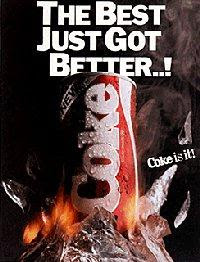Happy Birthday Coca-Cola

The first Coca-Cola recipe was invented in Covington, Georgia, by John Stith Pemberton, originally as a cocawine called Pemberton's French Wine Coca in 1885.
In 1885, when Atlanta and Fulton County passed Prohibition legislation, Pemberton responded by developing Coca-Cola, essentially a carbonated, non-alcoholic version of French Wine Cola. The beverage was named Coca-Cola because, originally, the stimulant mixed in the beverage was coca leaves from South America. In addition, the drink was flavored using kola nuts, also acting as the beverage's source of caffeine. Pemberton called for five ounces of coca leaf per gallon of syrup, a significant dose, whereas, in 1891, Candler claimed his formula (altered extensively from Pemberton's original) contained only a tenth of this amount. Coca-Cola did once contain an estimated nine milligrams of cocaine per glass but after 1904 Coca-Cola started using, instead of fresh leaves, "spent" leaves - the leftovers of the cocaine-extraction process with cocaine trace levels left over at a molecular level. However, as cocaine is one of numerous alkaloids present in the coca leaf, it was nevertheless present in the drink. Today, the flavoring is still done with kola nuts and the "spent" coca leaf. In the United States, there is only one plant (in New Jersey) authorized by the Federal Government to grow the coca plant for Coca-Cola syrup manufacture.
Coca-Cola was initially sold as a patent medicine for five cents a glass at soda fountains, which were popular in the United States at the time thanks to a belief that carbonated water was good for the health. Pemberton claimed Coca-Cola cured a myriad of diseases, including morphine addiction, dyspepsia, neurasthenia, headache, and impotence. The first sales were made at Jacob's Pharmacy in Atlanta, Georgia, on May 8, 1886, and for the first eight months only nine drinks were sold each day. Pembe rton ran the first advertisement for the beverage on May 29 of the same year in the Atlanta Journal.
rton ran the first advertisement for the beverage on May 29 of the same year in the Atlanta Journal.
Coca-Cola was initially sold as a patent medicine for five cents a glass at soda fountains, which were popular in the United States at the time thanks to a belief that carbonated water was good for the health. Pemberton claimed Coca-Cola cured a myriad of diseases, including morphine addiction, dyspepsia, neurasthenia, headache, and impotence. The first sales were made at Jacob's Pharmacy in Atlanta, Georgia, on May 8, 1886, and for the first eight months only nine drinks were sold each day. Pembe
 rton ran the first advertisement for the beverage on May 29 of the same year in the Atlanta Journal.
rton ran the first advertisement for the beverage on May 29 of the same year in the Atlanta Journal.By 1888, three versions of Coca-Cola — sold by three separate businesses — were on the market. Asa Griggs Candler acquired a stake in Pemberton's company in 1887 and incorporated it as the Coca Cola Company in 1888. The same year, while suffering from an ongoing addiction to morphine, Pemberton sold the rights a second time to four more businessmen: J.C. Mayfield, A.O. Murphey, C.O. Mullahy and E.H. Bloodworth. Meanwhile, Pemberton's alcoholic son Charley Pemberton began selling his own version of the product.
In an attempt to clarify the situation, John Pemberton declared that the name Coca-Cola belonged to Charley, but the other two manufacturers could continue to use the formula. So, in the summer of 1888, Candler sold his beverage under the names Yum Yum and Koke. After both failed to catch on, Candler set out to establish a legal claim to Coca-Cola in late 1888, in order to force his two competitors out of the business. Candler purchased exclusive rights to the formula from John Pemberton, Margaret Dozier and Woolfolk Walker. However, in 1914, Dozier came forward to claim her signature on the bill of sale which had been forged, and subsequent analysis has indicated John Pemberton's signature was most likely a forgery as well.
In 1892, Candler incorporated a second company, The Coca-Cola Company (the current corporation), and in 1910 Candler had the earliest records of the company burned, further obscuring its legal origins. Regardless, Candler began marketing the product — the efficiency of this concerted advertising campaign would not be realized until much later. By the time of its 50th anniversary, the drink had reached the status of a national icon for the USA. In 1935 it was certified kosher by Rabbi Tobias Geffen, after the company made minor changes in the sourcing of some ingredients.
For more information see Wikipedia which was the sole resource of information used for this post.

0 comments:
Post a Comment